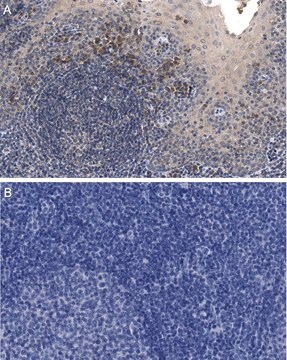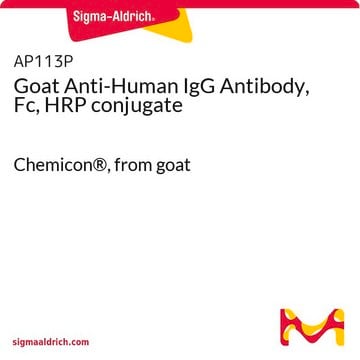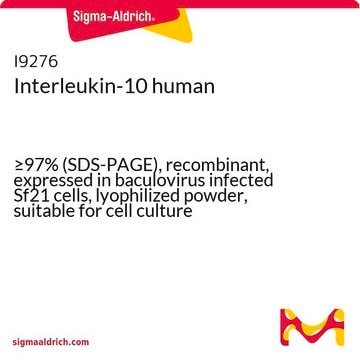MAB1004
Anti-Interleukin-6 Antibody, clone 4B6
clone 4B6, Chemicon®, from mouse
Synonyme(s) :
IL-6
About This Item
Produits recommandés
Source biologique
mouse
Niveau de qualité
Forme d'anticorps
purified immunoglobulin
Type de produit anticorps
primary antibodies
Clone
4B6, monoclonal
Espèces réactives
sheep
Fabricant/nom de marque
Chemicon®
Technique(s)
ELISA: suitable
Isotype
IgG1
Numéro d'accès NCBI
Numéro d'accès UniProt
Conditions d'expédition
dry ice
Modification post-traductionnelle de la cible
unmodified
Informations sur le gène
sheep ... Il6(443406)
Spécificité
SPECIES REACTIVITY:
The antibody is likely to react with caprine (goat) IL-6.
Immunogène
Application
Optimal working dilutions must be determined by the end user.
Suggested ELISA Protocol For Ovine IL-6
1. Coat high capacity microtitre wells (e.g. Nunc maxisorp) with monoclonal anti-IL-6 antibody (Chemicon Catalog Number MAB1004) at a concentration of 5 μg/mL in 0.1 M carbonate buffer pH 9.6 overnight at 4ºC.
2. Wash wells 3 x with PBS + 0.05% Tween 20 (PBST).
3. Add samples to wells. Incubate at room temperature in a humidified box for 1 hour. Wash 3 x with PBST.
4. Dilute rabbit anti-IL-6 (Chemicon Catalog Number AB1839) 1:500 in PBST and add 100 μL to wells. Incubate at room temperature for 30 minutes. Wash 3 x with PBST.
5. Dilute anti-rabbit IgG-HRP to appropriate level in PBST and add 100 μL to wells. Incubate 30 minutes at room temperature. Wash 3 x with PBST.
6. Add 100 μL of TMB chromagen to each well. Incubate for 5-10 minutes and stop reaction with 50 μL of 2M sulfuric acid.
Notes:
The anti-rabbit IgG HRP must be adsorbed against mouse immunoglobulin, and should be checked for non-reactivity with coated plates.
Non-specific binding may be reduced by addition of protein such as skim milk powder to the diluents.
Assay sensitivity may be altered by adjusting incubation times and reagent concentrations.
Inflammation & Immunology
Cytokines & Cytokine Receptors
Forme physique
Stockage et stabilité
Autres remarques
Informations légales
Clause de non-responsabilité
Not finding the right product?
Try our Outil de sélection de produits.
Code de la classe de stockage
10 - Combustible liquids
Classe de danger pour l'eau (WGK)
WGK 2
Point d'éclair (°F)
Not applicable
Point d'éclair (°C)
Not applicable
Certificats d'analyse (COA)
Recherchez un Certificats d'analyse (COA) en saisissant le numéro de lot du produit. Les numéros de lot figurent sur l'étiquette du produit après les mots "Lot" ou "Batch".
Déjà en possession de ce produit ?
Retrouvez la documentation relative aux produits que vous avez récemment achetés dans la Bibliothèque de documents.
Notre équipe de scientifiques dispose d'une expérience dans tous les secteurs de la recherche, notamment en sciences de la vie, science des matériaux, synthèse chimique, chromatographie, analyse et dans de nombreux autres domaines..
Contacter notre Service technique







